人教版七年级上册Unit4优秀教案
- 格式:doc
- 大小:33.00 KB
- 文档页数:3
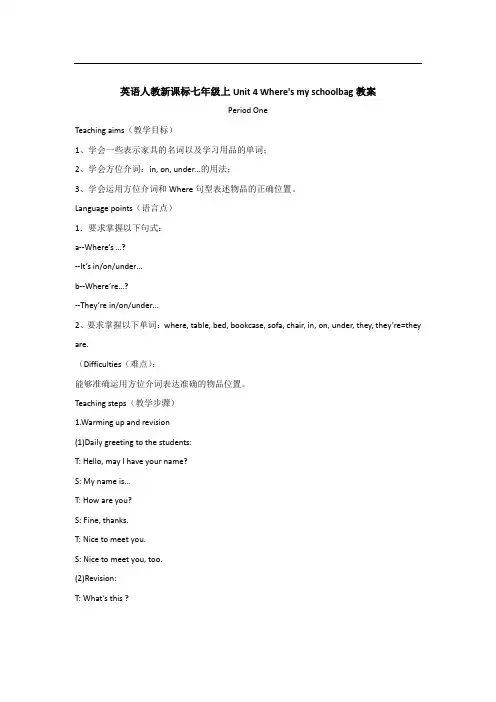
英语人教新课标七年级上Unit 4 Where's my schoolbag教案Period OneTeaching aims(教学目标)1、学会一些表示家具的名词以及学习用品的单词;2、学会方位介词:in, on, under…的用法;3、学会运用方位介词和Where句型表述物品的正确位置。
Language points(语言点)1.要求掌握以下句式:a--Where’s …?--It’s in/on/under…b--Where’re…?--They’re in/on/under…2、要求掌握以下单词:where, table, bed, bookcase, sofa, chair, in, on, under, they, they’re=they are.(Difficulties(难点):能够准确运用方位介词表达准确的物品位置。
Teaching steps(教学步骤)1.Warming up and revision(1)Daily greeting to the students:T: Hello, may I have your name?S: My n ame is…T: How are you?S: Fine, thanks.T: Nice to meet you.S: Nice to meet you, too.(2)Revision:T: What’s this ?S: It’s a pen.T: How do you spell it?S: P-E-N, pen.T: What color is it?S: It’s red.T: Good. Next, what’s that ?S: …2. Presentation(呈现新知识)Show the students a picture of a room, tell them this is a bedroom, let the students list the things in it first. Then show them the whole picture, teach the new words, ask where the things are, let the students answer, using the prepositions. 在新单词的教学过程中,一些有能力的学生可以将自己已有的认识水平与实际运用结合起来,使他们能体会到通过自主学习带来成功的满足感。
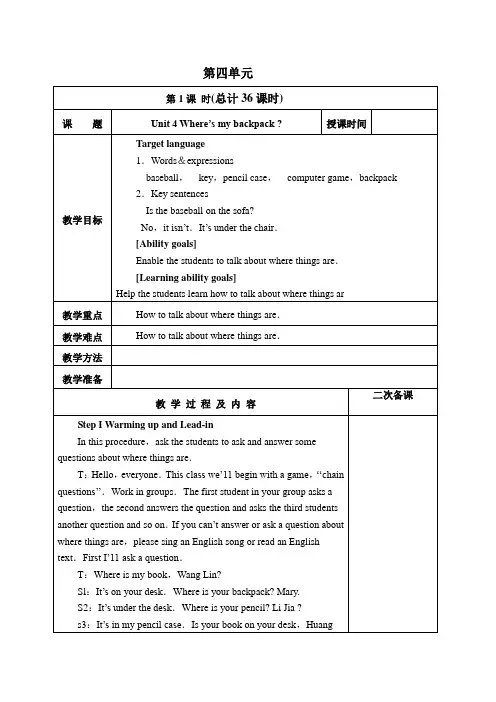
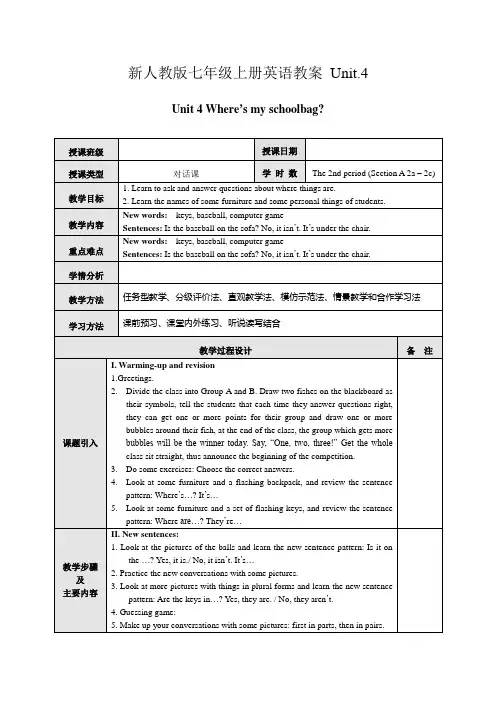
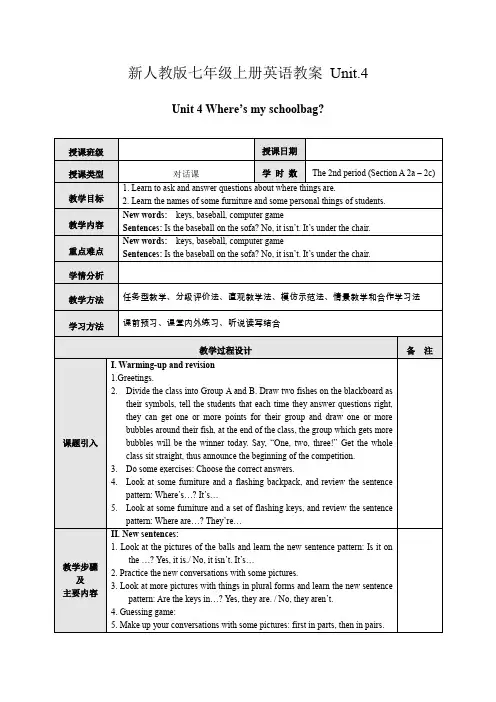
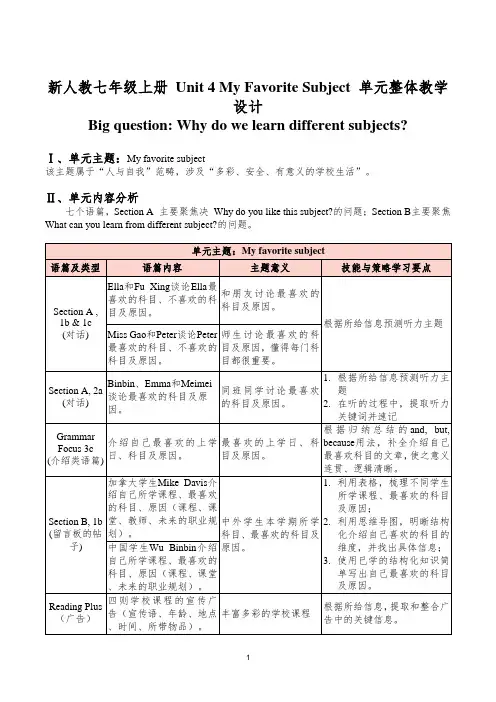
新人教七年级上册Unit 4 My Favorite Subject 单元整体教学设计Big question: Why do we learn different subjects?Ⅰ、单元主题:My favorite subject该主题属于“人与自我”范畴,涉及“多彩、安全、有意义的学校生活”。
Ⅱ、单元内容分析七个语篇,Section A 主要聚焦决Why do you like this subject?的问题;Section B主要聚焦What can you learn from different subject?的问题。
单元主题:My favorite subject语篇及类型语篇内容主题意义技能与策略学习要点Section A , 1b & 1c (对话) Ella和Fu Xing谈论Ella最喜欢的科目、不喜欢的科目及原因。
和朋友讨论最喜欢的科目及原因。
根据所给信息预测听力主题Miss Gao和Peter谈论Peter最喜欢的科目、不喜欢的科目及原因。
师生讨论最喜欢的科目及原因,懂得每门科目都很重要。
Section A, 2a (对话) Binbin、Emma和Meimei谈论最喜欢的科目及原因。
同班同学讨论最喜欢的科目及原因。
1.根据所给信息预测听力主题2.在听的过程中,提取听力关键词并速记Grammar Focus 3c (介绍类语篇) 介绍自己最喜欢的上学日、科目及原因。
最喜欢的上学日、科目及原因。
根据归纳总结的and, but,because用法,补全介绍自己最喜欢科目的文章,使之意义连贯、逻辑清晰。
Section B, 1b (留言板的帖子) 加拿大学生Mike Davis介绍自己所学课程、最喜欢的科目、原因(课程、课堂、教师、未来的职业规划)。
中外学生本学期所学科目、最喜欢的科目及原因。
1.利用表格,梳理不同学生所学课程、最喜欢的科目及原因;2.利用思维导图,明晰结构化介绍自己喜欢的科目的维度,并找出具体信息;3.使用已学的结构化知识简单写出自己最喜欢的科目及原因。
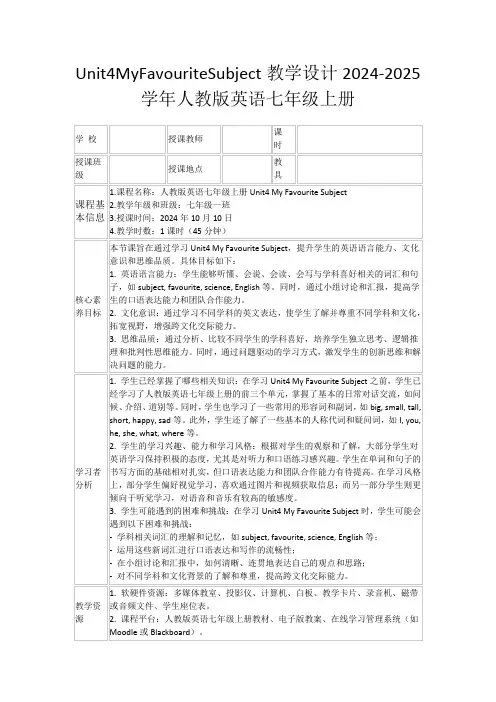
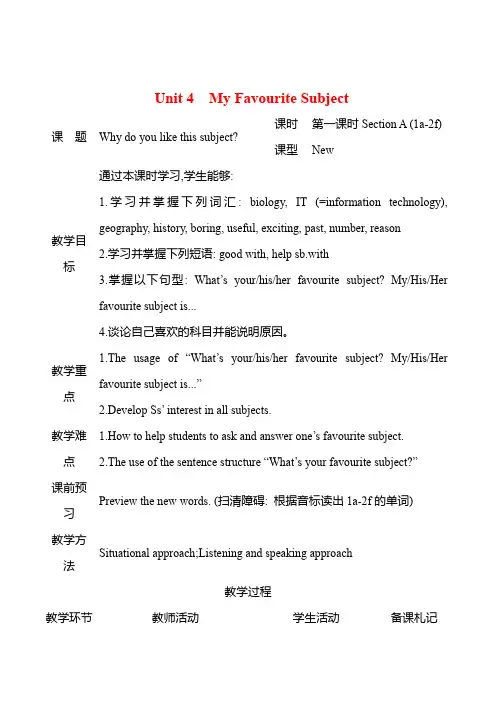
Unit 4My Favourite Subject课题Why do you like this subject?课时第一课时Section A (1a-2f)课型New教学目标通过本课时学习,学生能够:1.学习并掌握下列词汇: biology, IT (=information technology), geography, history, boring, useful, exciting, past, number, reason2.学习并掌握下列短语: good with, help sb.with3.掌握以下句型: What’s your/his/her favourite subject? My/His/Her favourite subject is...4.谈论自己喜欢的科目并能说明原因。
教学重点1.The usage of “What’s your/his/her favourite subject? My/His/Her favourite subject is...”2.Develop Ss’ interest in all subjects.教学难点1.How to help students to ask and answer one’s favourite subject.2.The use of the sentence structure “What’s your favourite subject?”课前预习Preview the new words. (扫清障碍: 根据音标读出1a-2f的单词)教学方法Situational approach;Listening and speaking approach教学过程教学环节教师活动学生活动备课札记Step1 Warm up and work on1a 1.利用插图或实物卡片让学生找出在预备篇中所学的单词,然后教师引导学生读出这些单词,并把学科名词与图画相匹配2.让学生听这些单词,然后让学生自读。
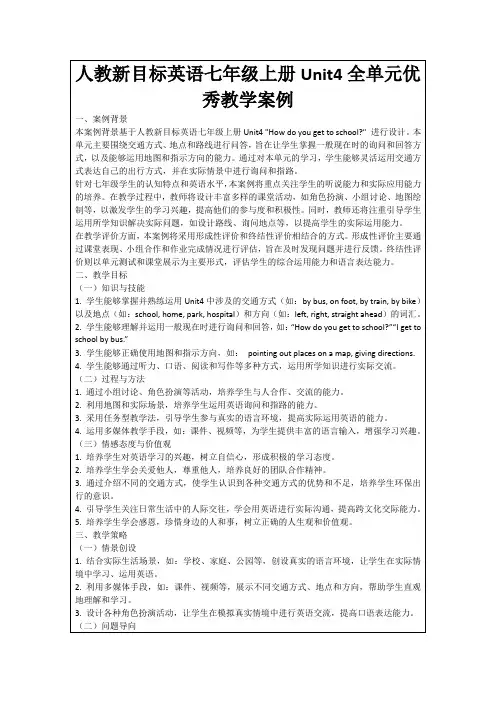
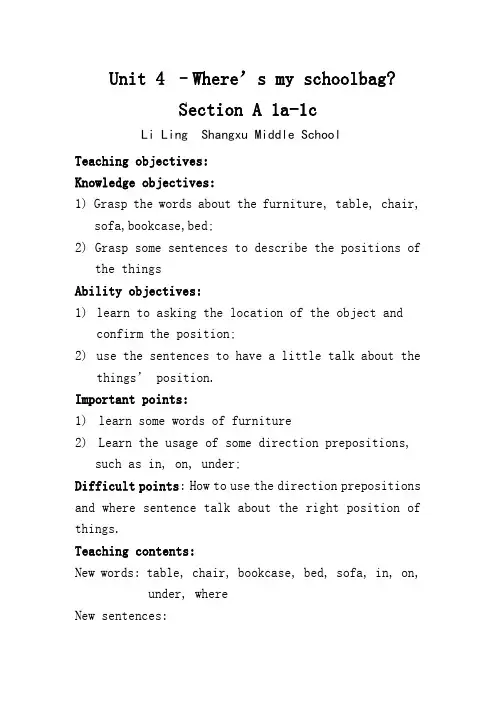
Unit 4 –Where’s my schoolbag?Section A 1a-1cLi Ling Shangxu Middle SchoolTeaching objectives:Knowledge objectives:1) Grasp the words about the furniture, table, chair,sofa,bookcase,bed;2) Grasp some sentences to describe the positions ofthe thingsAbility objectives:1) learn to asking the location of the object andconfirm the position;2) use the sentences to have a little talk about thethings’ position.Important points:1) learn some words of furniture2) Learn the usage of some direction prepositions,such as in, on, under;Difficult points: How to use the direction prepositionsand where sentence talk about the right position ofthings.Teaching contents:New words: table, chair, bookcase, bed, sofa, in, on,under, whereNew sentences:1) Where is .....? It is on/ under/in/....2) where are .....? They are .....Teaching aids: blackboard, chalk, multimedia, paper, box.Teaching procedures:Step1. Review1.Talk with individual S to reviewing the following English:What’s this?/It’s a(n)…/Is this(that) your…/Yes,it is. It’s mine./No, it isn’t. It’s his/Are these(those) your…?/Yes, they are. They’re mine./No,they aren’t. They’re hers.T:What’s this? (There is a pen in the teacher’s hand.) S1: It's a pen.T: Is this yours?S1: Yes, it is.T: OK. Here you are. Now pay attention to this, theseare his/her books. Are these your books?S2: No,they aren’t.They’re his/hers.T: Excellent.(Hold up a pen, an erase, some books and so on. Ask the questions in the same way.)Step2. Autonomic learning ( New words)1. Prepare some pictures about furniture, ask the wholeclass “What’s this” and ask Ss to read the new words, such as bookcase, sofa, table, chair, bookcase, bed.etc.2. Ask several Ss to read and spell the new words.3. Play a game4. Finish 1a.(Write "table, sofa, chair, bookcase, bed " on the blackboard. )Step3. Lead-inShow a picture,and tell something about the picture, For example,T: A friend called Tom comes to our class today. He will have English class with you. Tom has a very big and beautiful room,Do you want to have a look?S: Yes.T: OK,but you must finish the task first,three tasks. Step4. Task 1: Look for Tom.1. Show some picture about Tom,ask the whole class T:Where’s Tom?( teach students to read where’s= where is) It’s on the box.S: It’s on the box.(teach students to read on, on ,on the box)T: Where’s Tom? It’s in the box.S:It’s in the box. (teach students to read in, in ,in the box)T: Where’s Tom? It’s under the box.S: It’s under the box. (teach students to read under, under ,under the box)(Write "in, on, under, Where’s Tom? It’s on the box " on the blackboard. )3. Do an exercise ( Look and Say)1) Show some picture , ask and answer.T: Where’s Tom?S: He’s under the table. …3)To describe the positions of the things in classroom,such as:T: Where is my book? It’s on the desk. (Put a book on the desk.)S1: It’s on the desk.T: Where is my pen? It’s in the pencil case. (Put a pen in the pencil case and ask.)S2: It’s in the pencil box.T: Where is my schoolbag? (Put a schoolbag under the desk and ask this question.)S3: It's under the desk.T: Where is my schoolbag? (To all the students)S s: It’s under the desk.4. Do actions.Ask the whole class to stand up and follow you do the actions. For example,T:on ,on ,on the desk( put the English book on the desk ) S:on ,on ,on the desk( put the English book on the desk )Put the English book in/under the desk and say. Then let the student do it by themselves again as quickly as they can.Step4. Task 2: Help Tom1. Show some picture that the student can’t see clearly,and ask,T: Where is the ball?S: It’s under the table.Show other pictures ,let the sudents ask and answer each other. Then show book on the desk, and ask,T: Where is the book?S: It’s on the desk?2. Show another book on the desk ,and ask,T: How many books are there ?S: Two.T:Where are the books? They are on the desk.S: They are on the desk.(Write " Where are the books? They are on the desk " on the blackboard. )3. Do an exercise ( Look and Say)1) Show some picture , ask and answer.T: Where are the balls?S: They are on the table. …2) To describe the positions of the things in classroom, such as:T: Whereare my book? They are on the desk. (Put somebooks on the desk.)S1: They are on the desk.T:Where are my pens? They are in the pencil case. (Put pens in the pencil case and ask.)S2: They are in the pencil box….4. Pairwork.Show some pictures and ask the students makeconversation in pairs5. GroupworkShow some sentences ,let the students discusstogether and find out the rules about how to use “is, are”.6. Do exercises1) The books ______ in the bookcase.2) The pen ______ on the desk.3) Where______ the map?4) The cat _______ under the desk.5) The keys ______ on the sofa.6) Where _______ the rulers?7) The schoolbag _______ on the bed.8) The cups _______ on the table.Step5. Task: Listen to Tom.Listeninga. Let Ss listen to the tape and finish 1b.b. Check the answers with the class.Step6. Emotion educationFinish the three tasks and get to Tom’s room. Showa picture about Tom’s room, and ask,T: Is it beautiful?S: Yes.T: Is it clean and tidy?S: Yes.Show another room ,and ask in the same way.T: Is it beautiful?S: No.T: Is it clean and tidy?S: No.Compare the two pictures ,teach students to keep their things clean and tidy.Step6. Choose the present and finish the exercises.一、英汉互译:1. 桌子 _______2.书架,书橱 _______3. 在...下______4.chair_____5. sofa ____二、翻译句子。
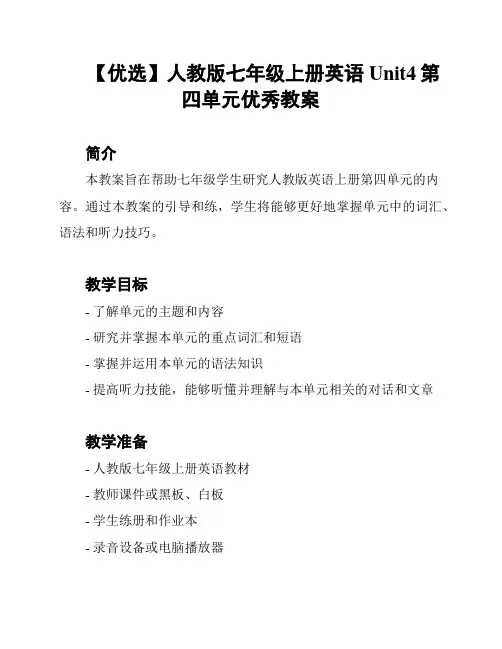
【优选】人教版七年级上册英语Unit4第四单元优秀教案简介本教案旨在帮助七年级学生研究人教版英语上册第四单元的内容。
通过本教案的引导和练,学生将能够更好地掌握单元中的词汇、语法和听力技巧。
教学目标- 了解单元的主题和内容- 研究并掌握本单元的重点词汇和短语- 掌握并运用本单元的语法知识- 提高听力技能,能够听懂并理解与本单元相关的对话和文章教学准备- 人教版七年级上册英语教材- 教师课件或黑板、白板- 学生练册和作业本- 录音设备或电脑播放器教学步骤步骤一:引入新单元1. 利用图片、视频或简短的对话引入新单元的主题,并与学生进行互动交流。
2. 提出几个问题,引导学生思考与本单元相关的话题,并鼓励他们用英语表达自己的观点和想法。
步骤二:研究词汇和短语1. 引导学生通过教材中提供的词汇表,研究本单元的重点词汇和短语。
2. 进行词汇练活动,如听写、填空或配对练,以帮助学生巩固词汇记忆和拓展词汇运用能力。
步骤三:研究语法知识1. 介绍并讲解本单元的语法知识点,如简单现在时的用法或名词的复数形式等。
2. 进行语法练活动,如填空、改错或翻译练,以帮助学生掌握和运用语法知识。
步骤四:提高听力技能1. 播放与本单元相关的录音材料,如对话或短文,并提供听力理解题目。
2. 让学生跟读录音材料,以帮助他们提高听力技能和语音表达能力。
步骤五:巩固和练1. 分发练册或作业本上的相关练题,让学生进行独立或小组完成。
2. 监督学生完成练,并提供必要的指导和反馈。
步骤六:总结和复1. 回顾本单元的主要内容和研究成果。
2. 进行小结性的问答或讨论活动,帮助学生巩固对本单元的理解和记忆。
教学评估- 观察学生在课堂活动中的参与程度和表现- 收集并批改学生完成的练和作业- 进行口头测试或小测验,评估学生对本单元知识的掌握情况教学延伸- 鼓励学生进行口语对话练,以提高他们的口语交流能力- 制作课堂展示活动,让学生展示他们对本单元内容的理解和研究成果参考资源- 人教版七年级上册英语教材和练册- 相关英语学习网站和应用程序。
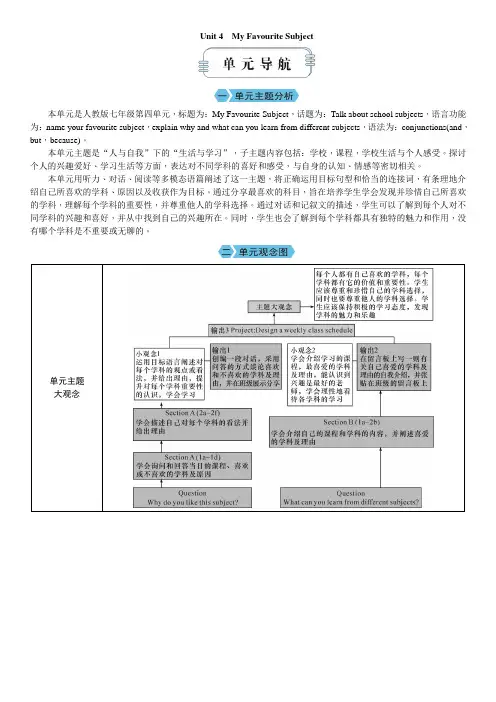
Unit 4 My Favourite Subject本单元是人教版七年级第四单元,标题为:My Favourite Subject,话题为:Talk about school subjects,语言功能为:name your favourite subject,explain why and what can you learn from different subjects,语法为:conjunctions(and,but,because)。
本单元主题是“人与自我”下的“生活与学习”,子主题内容包括:学校,课程,学校生活与个人感受。
探讨个人的兴趣爱好、学习生活等方面,表达对不同学科的喜好和感受,与自身的认知、情感等密切相关。
本单元用听力、对话、阅读等多模态语篇阐述了这一主题,将正确运用目标句型和恰当的连接词,有条理地介绍自己所喜欢的学科、原因以及收获作为目标。
通过分享最喜欢的科目,旨在培养学生学会发现并珍惜自己所喜欢的学科,理解每个学科的重要性,并尊重他人的学科选择。
通过对话和记叙文的描述,学生可以了解到每个人对不同学科的兴趣和喜好,并从中找到自己的兴趣所在。
同时,学生也会了解到每个学科都具有独特的魅力和作用,没有哪个学科是不重要或无聊的。
单元主题大观念单元语言大观念语言能力及技能语言能力:1.掌握与学科相关的词汇和常用表达,如:magic,useful,fun,important,subjects,difficult,easy,Chinese,history,maths,English,music,PE,geography,biology,IT,art,learn about the past,help me with my maths,work out maths problemsKey sentences:①—What's your favourite subject?—My favourite subject is…②—Why do you like…?—Because it's…③I'm good with numbers.④I'm not good at science.2.掌握双元音/e/,/a/,//,/əu/,/au/,/ə/,/eə/,/uə/的字母组合发音和单词连读。
池河中学2017-2018学年度第一学期教学设计年级七年级科目英语任课教师邓梦婷授课时间10.23课题Unit 4 Where’s my schoolbag?Section A (Grammar Focus)授课类型语法课标依据本单元围绕着Where is my schoolbag?的话题,共设计了三个部分的内容。
通过教授本单元,使学生学会谈论房间里物品的位置,能读懂有关物品位置的便条,并学会写便条让朋友帮自己从房间里取东西。
教学目标知识与技能1)掌握名词的单、复数形式与be动词、特殊疑问词where之间的关系。
2)能够正确使用where 引导的特殊疑问句询问物品位置。
3)能够正确使用介词 on, in, under描述物品的所在位置。
过程与方法通过学生自主学习总结,讲授练习等方法开展此部分教学。
编号:28情感态度与价值观学生能在多种英语学习情景中体验用英语交流的成功与喜悦,以及培养合作精神、互助精神和创新精神。
通过话题启发学生积极思考,调动学生的学习兴趣。
教学重点难点教学重点重点词汇: things in the room and some prepositions: on in underbehind next to语言结构:Where is/are….?It is…/They are…on,in,under,behind,next to …教学难点1.能够辨认位置,并描述物体所在位置。
2.能根据物体所在位置进行简单的问答。
教学过程师生活动设计意图设计Lead-in: Greeting with students as usual. Step 1 Read the grammar focus.Task 1 认真朗读P9 Grammar Focus 表格中的句子,仔细观察其中的语法语义规律。
1) 观察be ( is ,are )动词和名词间的对应关系,填一填。
Where _____ the map? Where _____ my books?2) 观察表格中的句型变化,试着填一填, 并说出句子中表黑单词的意思。
精选】人教版七年级上册英语Unit4第四单元优秀教案Unit 4 Where's My School Bag?n A (1a-1c)XXX:1.Key words: where。
table。
bed。
bookcase。
sofa。
chair。
on。
under2.Key phrases: on the sofa。
in your bag。
under your bed3.Key XXX:Where are my books?They are on the sofa.Where's my pencil box?It'XXX.Where's my computer game?It's under your bed.Focus of Learning:1.Correct use of special XXX "where"2.Describing the n of items using nal phrasesDifficulties in Learning:1.Correct use of special XXX "where"2.Describing the n of items using nal phrasesSelf-Study:1.Preview the new words on page 19 and memorize them。
Complete the following n from Chinese to English:Where: ________ 2.Table: ________ 3.Bed: ________ 4.Sofa: ________ 5.Chair: ________ 6.On: ________ 7.Under: ________2.Carefully preview 1a。
1b。
and 1c。
人教版七年级英语上册第4单元Unit4教案Step 1: Free TalkXXX to the students。
such as "What's this?" and "It's。
"。
This is done to create a XXX。
thus initiating the learning process.Step 2: XXXXXX the students' memory。
They review the words usly learned。
and the students are asked to say the words out loud。
Then。
the XXX and asks the students to find some objects in their classroom。
using the words they have learned.Next。
the teacher moves on to 1a。
where the students are asked to match the furniture words with the pictures。
After that。
they listen to a recording and complete 2a。
The purpose of this step is to help the students learn and master the sentence patterns used to ask about the n of objects。
as well as the ns "on"。
"in"。
and "under"。
They also learn new words such as "bed"。
Unit 4 Where’s my schoolbag?一、教学目标1.学习一些有关家具物品和学习用品的单词2.运用方位借此表述物体位置3.掌握where问句的回答、一般疑问句提问并用方位介词回答4.学习名词单复数及人称代词they的用法二、能力目标1.学会正确描述物品作在的位置;2.学会询问自己或他人物品的具体位置;3.能够合理地描述和设计房间。
三、情感目标培养学生整齐地摆放自己物品的生活习惯。
四、语言目标1.词汇: Rooms of the house, furniture, table, bed, sofa, chair, desk, radio, clock, tape, tape player, model plane, on, under, where, their, Come on2.句型:Where is his pencil?It is in his schoolbag.Where’s your ruler?It’s under the chair.Where are my books?They’re on the sofa.五、教学重点:1.方位借此in, on, under, behind, in front of, near等的用法2.where的特殊疑问句和一般疑问句Is the…in/on/under…?的肯定、否定回答。
3.新单词: bed, dresser, table, bookcase, backpack…六、教学难点:1.能够准确运用方位借此描述物品所在的位置2.能够运用where问句找到物品的位置。
七、课时安排The 1st period (第一课时): Section A (1a –2d)The 2nd period (第二课时): Section A (Grammar focus – 3c)The 3rd period (第三课时): Section B (1a- 1e)The 4th period (第四课时): Section B (2a- 2c )The 5th period (第五课时): Section B (3a- Self Check )The 1st period (第一课时): Section A (1a –2d)Teaching aims(教学目标)1. 掌握有关物品的名称table, bed, dresser, bookcase, sofa, chair, drawer, plant, bag, alarm clock, CD, video, video cassette, hat, etc;2. 学会谈论物品的位置。
七年级英语上册 Unit 4(第一课时)优课展评教案及反思人教新目标版Time: 6th,AprilPlace: JianhuMiddle SchoolContent: Comic strips & Welcome to the unit一、设计理念1.面向全体学生,让每个学生了解掌握本课时关于食物的所授内容。
2.教师注重情感的真切投入,使得学生积极参与到课堂活动中来。
3.以教学目的确定材料和手段,创造性地开发课程资源。
4.充分利用现代多媒体技术,给学生营造立体式的学习场景。
5.让课堂充满活跃气氛,让学生感悟知识的价值,使学习变得丰富有趣。
二、教学目标1.帮助学生认识食物,描述食物,并能谈论喜欢与不喜欢的食物。
2.学生能用所学的食物单词完成一系列对话和活动。
3.以中西文化为背景,讨论健康饮食话题。
三、教学重点及难点食物单词,有关喜好的句型,及深入讨论健康问题。
四、教学流程Step1 Warm-up talk Step2 Lead inStep3 Play a gameStep4 Talk about the tableStep5 Make a survey.Step6 Present the comic stripsStep 7 ActingStep8 Selling.Step9Discuss how to be healthy.五、教具准备图片、食物、磁带,多媒体。
六、板书设计Unit 4FoodGroup 1 2 3 4 Total hungryI like … ↓What food do you like?hamburgerricevegetables↓energynever教学反思盐城初级中学徐霞这堂课教学的内容是牛津英语7A Unit 4 Food Comic strips & Welcome to the unit. 主要是面向全体学生,让每个学生了解掌握本课时关于食物的所授内容。
英语七年级上册人教版unit4教案课程名称:英语七年级上册人教版unit4教案一、教学目标1.掌握本单元的主要词汇和短语;2.能够听、说、读、写有关家庭成员的表达;3.能够运用所学知识描述自己的家庭成员。
二、教学重点和难点1.教学重点:掌握本单元的主要词汇和短语,能够听、说、读、写有关家庭成员的表达;2.教学难点:能够运用所学知识描述自己的家庭成员。
三、教学过程1.导入新课–利用图片等教具帮助学生了解本单元的内容和主题。
–引导学生回忆和叙述自己的家庭成员。
2.学习新词汇和短语–教师给出单词和短语的中文意思,学生跟读并模仿发音。
–利用图片和实物等教具帮助学生理解和记忆新词汇和短语。
3.听力训练–播放相关的听力材料,让学生听并回答问题。
–分组进行听力练习,让学生互相提问并回答。
4.口语训练–设计各种情景对话,让学生进行角色扮演,练习运用所学知识进行对话。
5.阅读训练–分发阅读材料,让学生阅读并回答问题。
–设计相关的阅读任务,让学生合作阅读,并互相询问答案。
6.书面表达–让学生运用所学知识,描述自己的家庭成员。
–提供范文和写作模板,帮助学生完成作文。
7.温故知新–设计一些小游戏和测试,复习本单元的知识和内容。
四、教学评价1.通过听、说、读、写的综合训练,评价学生对本单元知识的掌握情况。
2.设计相关练习和测试,对学生的能力进行评价。
五、教学资源1.课件及相关教具;2.单词卡片、图片和实物等教具;3.听力材料、阅读材料和相关练习题;4.范文和写作模板;5.小游戏和测试题。
六、拓展阅读•推荐学生找一些有关家庭成员的英语文章进行阅读,提高阅读能力和理解能力。
七、课后作业1.背诵本单元的重点词汇和短语;2.完成相关的听力和阅读练习题;3.完成书面作业,描述自己的家庭成员。
八、板书设计•Unit 4: My Family•Vocabulary: father, mother, brother, sister,grandparents, cousin, uncle, aunt•Phrases: in front of, next to, between, on the left/right of九、教学反思根据学生的实际情况和进度,灵活调整教学策略和教学内容。